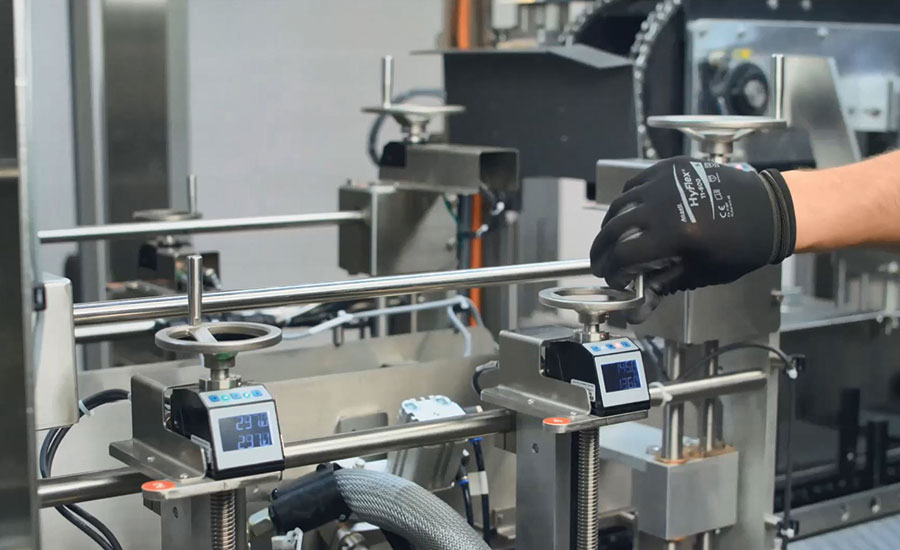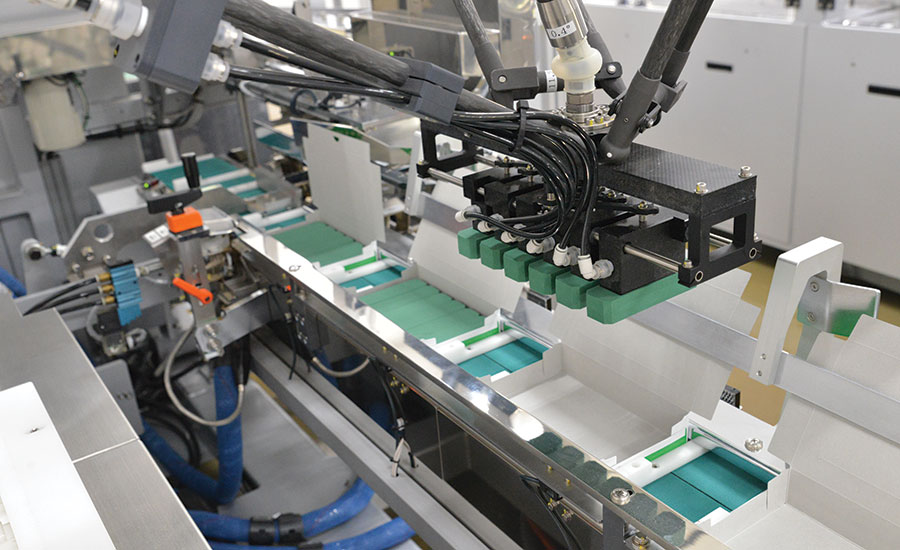As production facilities continue to be challenged by smaller batch runs, higher OEE requirements and skilled labor shortages, there is a desire for simpler, more flexible equipment. One way to achieve more flexibility is by addressing the time, tools and parts needed to implement changeovers.
Size changeover can be accomplished by a variety of methods. The most common methods historically involved a cart full of change parts, manual adjustments using slots and scales, or manual adjustments with digital (mechanical) counters. Some machines still use a combination of all three.
The change part cart methodology, using carton template plates, drop in guides/plows and pushers, can be the most reliable of these three, but it can also be cumbersome for storage if the line has to run more than a couple of sizes. It also opens up the possibility of mixing up, losing or damaging these parts once they are removed from the machine.
Manual adjustment methods solve the issues associated with change part carts because items are not removed from the machine. They can be provided with or without tools with most end users preferring tool-less methods.

The use of slots and scales are the most cost effective. However, it also tends to be the least precise method, as the scale requires some operator interpretation. Manual adjustments with digital counters have proven to be far more accurate, but there is a cost associated with providing a mechanism for the counter to attach to. There also isn’t a way to verify that all changeover points have been adjusted to the correct set point. So, all of these methods provide flexibility, but none of them offers the “fool-proof” setup that is desired for vertical start-ups driven by OEE requirements.
Another approach to changeover involves putting servo motors on changeover mechanisms. This method provided the “fool-proof” pushbutton changeover that production facilities desired, but it came with a high price tag. The high cost was associated with the servo technology required to coordinate multi-axis motion control. This required expensive hardware, larger electrical panels and additional programming by an electrical engineer. This method provided challenges from a budgetary standpoint.
Thanks to recent advancements in changeover technology there are now additional possibilities to help achieve vertical start-up demands. The new technologies include RFID, digital (electronic) counters with communication to the machine controller, and low-voltage smart motors that can provide accurate and reliable device positioning without the need of expensive hardware for coordinated multi-axis motion control.
RFID technology has improved and continues to evolve into smaller, less expensive formats, lending itself to be used for part verification if change part methods are used.
Digital counters with feedback can be used in conjunction with manual adjustments to verify all changeover points are set to the correct position.
Smart motors can be used to automatically adjust changeover points and provide a more cost-effective approach to push-
button changeover.
These new technologies provide manufacturers with multiple changeover solutions to match their methodology and budget restrictions. Identified below are three levels of changeover capabilities manufacturers should inquire about when seeking new cartoning technology from a secondary packaging equipment provider.
Standard Changeover
- Battery-powered electronic counters on rotary adjustment devices
- Kipp handle & scale manual adjustment devices for all other settings
- Tool-less product change parts
- Calibration sheets supplied for each SKU/carton size
Semi-Automatic Validated Changeover
- All set points are validated, ensuring vertical start-up
- Electronic digital counters with feedback on existing rotary adjustment devices and electronic operator verification on kipp handle & scale adjustment devices
- RFID technology for verification of carton sizes listed above
- Includes mobile HMI tablet for manual verification points, as well as redundant machine control
- Calibration sheets supplied for each SKU/carton size
Automatic Validated Changeover
- All set points are set automatically through the machine controller, reducing changeover time and ensuring vertical
- start-up (still requires product change parts)
- Smart motors added to existing rotary adjustment devices and select linear adjustments for automatic changes
- The linear adjustments will have feedback to the PLC, removing the need for touch-to-verify feature on the handheld HMI
- RFID technology for verification of carton sizes listed above
- Includes mobile HMI tablet for redundant machine control
R.A JONES offers standard changeover, semi-automatic and automatic validated changeover solutions for a variety of new cartoning equipment. The company is a global leader in the design and manufacture of primary and secondary packaging machinery for the food, pharmaceutical, dairy and consumer goods industries. R.A JONES is a part of Coesia, a group of innovation-based industrial and packaging solutions companies operating globally and headquartered in Bologna, Italy.
Visit rajones.com for more information.
|
The Need for Speed Tri-seal carton packaging gets speed from robotics.The integration of robotics with packaging equipment is certainly not new, but using robotics with a cartoner is. By integrating robotics into a cartoner, manufacturers can achieve more consistent, high-quality cartons and more accurate product placements in the cartons at higher speeds with less downtime. Robots allow packagers to adjust the equipment so it best suits their needs, either tailored to specific product characteristics or the end application. End-of-arm tooling, buckets and containers can all be changed out to provide an exact solution for any packaging challenge — from carton and flow-wrapped products to bagged and thermoformed packages.

Features of robotic carton loading systems include high-speed delta pick-and-place robots that provide consistent and accurate product placement. Some systems will include special turrets that reorient products and packages to prepare them for loading into secondary packaging. These devices help eliminate product buildups on the line and product flipping, in addition to more gentle handling that reduces any packaging material scratching, punctures or pinholes. As product is placed onto a pick conveyor or other product orientation device such as a track or pocket, cartons are simultaneously formed on most systems. Typically, tri-seal cartons are formed by way of a mandrel pressing the sheet down into a form to create a carton. A new way of forming the tri-seal carton is to form it around the actual mandrel or forming device. In this case, the sheet is controlled the entire time, which creates high-quality, more accurate cartons compared to typical tri-seal cartoners. Some packaging equipment manufacturers are taking cues from the automotive industry. On the tri-seal top-load cartoner from PMI KYOTO, robots feature arms made out of lightweight carbon shafts. The lightweight arms or shafts help the robot move at a quicker pace and allow for high-speed carton loading. The accuracy and speed of the robot gives obvious benefit to manual loading applications. When compared to typical mechanical solutions, the gentle handling of the robot helps reduce or eliminate any damage to the primary product or primary packaging of the product. By integrating robotics into cartoning applications that revolve around difficult-to-handle products, manufacturers can now fully automate operations and perform at higher speeds. Integrating robotics specifically with a tri-seal top-load cartoner not only ensure the integrity of the product and form high-quality cartons but also the ability to package more quickly, efficiently and accurately. PMI KYOTO Packaging Systems was recently formed after PMI Cartoning, Inc. was acquired by Kyoto Seisakusho Co., Ltd. The company’s combined history and industry knowledge help its customers excel in high-speed and difficult-to-handle products. For more information, visit pmikyoto.com. |

